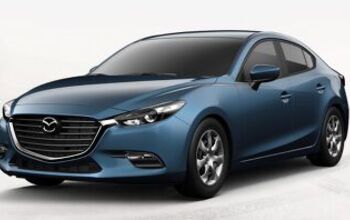Ace of Base: 2017 Mazda MX-5 Miata Sport

Sometimes a manufacturer churns out a base model in which it might be more prudent to spend one’s extra cash on aftermarket upgrades and not a more expensive trim. Here’s a candidate.
Many songs of praise have been penned and much digital ink spilled of Mazda’s rear-wheel drive, two-seat roadster. From the original version in 1990 to the current fourth-gen model, Mazda has always managed to keep a lid on cost and weight, two things which generally spiral out of control in both successive iterations of a popular vehicle and my own personal lifestyle as I age.
A total of $5,150 separates the base MX-5 Sport from the top rung Grand Touring model. Is that sum of cash better spent on DIY upgrades? Or should buyers spring for the high-zoot MX-5? Let’s find out.
All iterations of the MX-5 deploy Mazda’s 155-horsepower 2.0-liter Skyactiv-G inline-four, so one’s extra cash is for naught down in the engine room. It’s a fantastic engine, somehow managing to be simultaneously efficient and fun. Armchair racers tend to cry for more powerrrrrr when yammering about the MX-5, but I think a bigger engine would simply upset what’s already a well-balanced 2,332-pound car.
One could make a case for the mid-range Club model, which offers 17-inch rubber and a front shock tower brace for a near $3,900 premium, but it would behoove shoppers to remember the vaunted Brembo/BBS package costs another $3,400 on top of the Club’s MSRP, leading to a $32,200 price tag. This makes opting for the base MX-5 an even tastier proposition, as the price difference grows to a not-insubstantial $7,285.
A brake kit from Flyin’ Miata runs about a grand, while a full Koni Stage 2 suspension package is less than $1,500. Even big-kit Brembo packages from Rev9, which deploy calipers from a Ferrari 360, are only about the same price as Mazda’s factory Brembo package. And, yes, I’m ignoring installation costs in those figures. You’re doing all this work yourself, right?
A sweet-shifting stick is standard and you should buy it; even considering an automatic-equipped MX-5 is tantamount to automotive treason. Leather covers the steering wheel and shifter knob in the base model, and the steering column adjusts for reach and rake. Air conditioning is on board for muggy days when the top stays up but the outside air feels like thick soup. The sole non-grayscale color on the MX-5 palette costs an annoying $300. Suck it up and get a black one. (Or get a white one because it’s 15-pounds lighter than the three-stage paint models. —Ed.)
Mazda is one of the few automakers that continues to refine and develop a rear-drive chassis for deployment on a single model. Nothing else in Mazda’s catalog shares it. Sure, its infotainment knobs are comfortably operated only by those with the arms of T-Rex, and its cup holders are directly astern of the driver’s elbow, but the driving experience more than makes up for any foibles. It is perfectly imperfect.
Would you buy a base Miata MX-5 and install a few aftermarket parts? Or would you sign the note on a $30,000+ model? My decision is clear. If there’s a better spend of $24,915 in a showroom today, I can’t think of it.
Not every base model has aced it. The ones which have? They help make the automotive landscape a lot better. Any others you can think of, B&B? Let us know in the comments. Naturally, feel free to eviscerate our selections.
The model above is shown in American dollars with American options and trim. As always, your dealer may sell for less.

Matthew buys, sells, fixes, & races cars. As a human index of auto & auction knowledge, he is fond of making money and offering loud opinions.
More by Matthew Guy
Latest Car Reviews
Read moreLatest Product Reviews
Read moreRecent Comments
- Formula m How many Hyundai and Kia’s do not have the original engine block it left the factory with 10yrs prior?
- 1995 SC I will say that year 29 has been a little spendy on my car (Motor Mounts, Injectors and a Supercharger Service since it had to come off for the injectors, ABS Pump and the tool to cycle the valves to bleed the system, Front Calipers, rear pinion seal, transmission service with a new pan that has a drain, a gaggle of capacitors to fix the ride control module and a replacement amplifier for the stereo. Still needs an exhaust manifold gasket. The front end got serviced in year 28. On the plus side blank cassettes are increasingly easy to find so I have a solid collection of 90 minute playlists.
- MaintenanceCosts My own experiences with, well, maintenance costs:Chevy Bolt, ownership from new to 4.5 years, ~$400*Toyota Highlander Hybrid, ownership from 3.5 to 8 years, ~$2400BMW 335i Convertible, ownership from 11.5 to 13 years, ~$1200Acura Legend, ownership from 20 to 29 years, ~$11,500***Includes a new 12V battery and a set of wiper blades. In fairness, bigger bills for coolant and tire replacement are coming in year 5.**Includes replacement of all rubber parts, rebuild of entire suspension and steering system, and conversion of car to OEM 16" wheel set, among other things
- Jeff Tesla should not be allowed to call its system Full Self-Driving. Very dangerous and misleading.
- Slavuta America, the evil totalitarian police state


































Comments
Join the conversation
I own a 2016 Mazda Miata Sport. It's my only car and it's great. Plus the Sport doesn't have the stupid dorsal fin the other trims do (due to satellite radio)
As a previous owner of two Miatas, this article has a great deal of merit. I considered purchasing an ND, but the total cost of the upgrades which I would have wanted (wheels, suspension stiffening, upholstery, audio, and cloth rather than vinyl top) pushed the cost WAYYYY out of range of what I wanted to pay. There are PLENTY of low-mile NBs and NCs around which are better candidates for much less money.